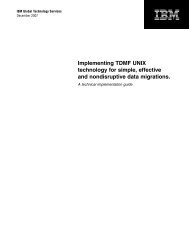A Primer for Healthcare Managers - IBM
A Primer for Healthcare Managers - IBM
A Primer for Healthcare Managers - IBM
You also want an ePaper? Increase the reach of your titles
YUMPU automatically turns print PDFs into web optimized ePapers that Google loves.
scope, technologies, costs, and IT direction of the<br />
client organization are some of the factors that may<br />
be beyond the direct management control usually<br />
available to in-house service provision (Ware,<br />
2002). Control is particularly difficult when a large gap<br />
exists between the client organization’s knowledge of<br />
services and the vendor’s. Client organizations have<br />
difficulty validating any claims that vendor organizations<br />
make, because they may not have access to<br />
critical in<strong>for</strong>mation possessed by the vendor <strong>for</strong><br />
claim validation.<br />
Security is another risk factor. Critical data may be<br />
stored in a facility outside the client organization.<br />
The network-connected in<strong>for</strong>mation systems of the<br />
client organization and those of the vendor may<br />
be subsequently subjected to security threats. If<br />
the main technology infrastructure of vendors is<br />
shared by multiple client organizations, there can<br />
be multiple sources of security threats. Security<br />
can also be an issue when security practices are<br />
problematic. Personnel training and background<br />
screening of IT personnel are important in addressing<br />
security threats.<br />
Costs/Risks of IT Outsourcing<br />
• Loss of control over service quality<br />
• Possibility of compromised security<br />
• Possibility of service disruption due to<br />
instability of vendors<br />
• Increased complexity of managing and<br />
monitoring the outsourcing contract<br />
• Prolonged procurement process<br />
• Union pressure and budgetary uncertainty<br />
The stability of vendors is considered by many client<br />
organizations as a major risk factor. The survival of<br />
vendors is dictated by the rules of the marketplace.<br />
Vendors that provide IT services may go out of business<br />
without clear warning signs. When that happens,<br />
client organizations may need to start the outsourcing<br />
process all over again. Merger and acquisition<br />
also pose problems <strong>for</strong> client organizations. It is<br />
commonplace in the in<strong>for</strong>mation technology industry<br />
to go through an initial boom and then shake-out<br />
period. Merger and acquisition are ways of restructuring<br />
the industry. If there are no terms and conditions<br />
specified in the outsourcing contract, client organizations<br />
may find themselves renegotiating them.<br />
Managing and maintaining an outsourcing<br />
contractual relationship poses some risks. After the<br />
contract is negotiated, client organizations need to<br />
transfer their technical and personnel resources<br />
to the vendor. Client organizations, if not properly<br />
prepared, will likely run into problems of poor service<br />
quality or a mismatch between organizational needs<br />
and service delivered by vendors. The complexity of<br />
relationship management is usually underestimated. If<br />
the transfer of knowledge about the existing system<br />
or needs <strong>for</strong> a new system at various levels of the<br />
organization is neglected or done poorly, the<br />
IT outsourcing arrangement may function efficiently<br />
but not in alignment with the organization’s strategic<br />
goals. Lack of proper monitoring of service level by<br />
the client organization may put it at risk of running<br />
into major service disruption. Poor communication<br />
and lack of a joint problem-solving mechanism may<br />
cause missed opportunities <strong>for</strong> early problem detection<br />
and continuous improvement.<br />
A Tool <strong>for</strong> Managing IT Outsourcing:<br />
A Process Methodology<br />
IT outsourcing usually goes through various stages<br />
from the initial decision to evaluate the viability<br />
of IT outsourcing to the implementation of an<br />
outsourcing contract. A process model can help in<br />
three ways. First, it is comprehensive enough to<br />
capture operational and management issues that<br />
could otherwise be ignored. For example, if managers<br />
think through the transition and management<br />
involved in an outsourcing project, they will have<br />
a better chance to succeed. The other advantage is<br />
the general applicability of the model. Despite the<br />
fact that situations may be different <strong>for</strong> various<br />
client/vendor arrangements, the process model<br />
is able to capture the management issues that<br />
are common <strong>for</strong> all IT outsourcing arrangements.<br />
For example, the need <strong>for</strong> organizational input in<br />
transition management is probably the same <strong>for</strong><br />
all arrangements. Lastly, a process methodology is<br />
adaptive to change. The main process remains relatively<br />
stable over time. The new service priority, such as<br />
security and business continuity, can be included as<br />
items, <strong>for</strong> example, in the service contract.<br />
<strong>IBM</strong> Center <strong>for</strong> <strong>Healthcare</strong> Management 9

















